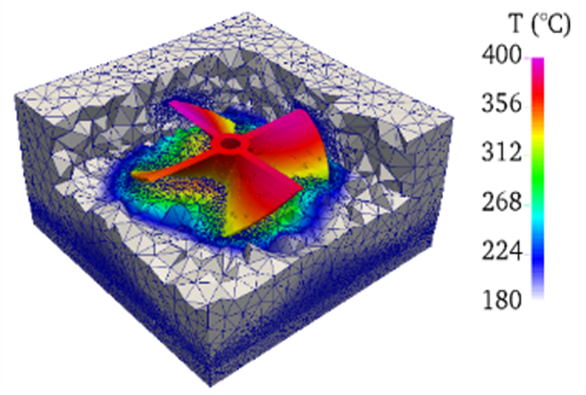Open PhD position: Numerical modeling of precipitation and optimization of “in situ” thermal treatments of LBM process on aerospace superalloys.
CEMEF PhD thesis: Numerical modeling of precipitation and optimization of “in situ” thermal treatments of LBM process on aerospace superalloys.
Global objective of work
Context
The development of increasingly efficient aircraft engines that consume less and less fuel requires the development of ever lighter parts that retain good thermomechanical properties at high temperature.
The manufacture of nickel-based superalloy parts by an additive process such as laser powder bed fusion (LPBF) seems permit to meet these objectives.
However, the production of parts with satisfactory thermomechanical properties currently remains a challenge, which requires the understanding, control and optimization of the microstructures generated during the shaping process. In particular, the thermal cycling generated by additive manufacturing process induces a precipitation/dissolution cycling of the hardening phases, possibly supplemented by heat treatment of the manufactured part. Thus, the control of the evolution of the precipitation during the process is necessary to optimize the use properties of the manufactured parts.
The NILS project defines collaborations between the Safran group and Mines Paris aimed at improving the properties of parts made of nickel-based superalloys using the LPBF process. It revolves around 4 theses carried out in close collaboration. The thesis proposed here aims to model and optimize the presence of hardening phases during the additive manufacturing process.
Detailed presentation
The thesis work consists in modeling the precipitation/dissolution sequences of the hardening phases during the additive manufacturing process for two nickel-based superalloys. This work can be split in two parts:
The first objective will be to model the thermal history of the part during its manufacture and at any point of the solidified metal. For this, the finite element model developed by Zhang et al. [1] will be used.

Fig.1 Modeling of the temperature field during the LPBF process[1]
The second objective is to develop a numerical model to predict the evolution of the distribution of precipitates according to the local thermal history of the material. For this, we will develop the mean field model PREC [2, 3] from the CEMEF PhysalurgY library [4]. This library constitutes a bank of tools for modeling microstructural evolutions coupled with the Thermo-Calc software and its thermodynamic databases [5].
These two modeling works and their coupling will make it possible to simulate the evolution of the distribution of precipitates during the manufacture of nickel-based superalloy parts by LPBF additive manufacturing. The simulation results will be confronted with experimental observations carried out on the one hand within the framework of another thesis of the NILS project, and on the other hand on the industrial equipment of Safran Additive Manufacturing Campus. Working in strong research-industry synergy will give the possibility to propose modifications to the process to optimize the manufacture of strategic engine components.
References:
[1] Zhang, Y., Gandin Ch.-A., Guillemot (2022). Finite Element Modeling of Powder Bed Fusion at Part Scale by a Super-Layer Deposition Method Based on Level Set and Mesh Adaptation. Journal of Manufacturing Science and Engineering 144 (5)
[2] Legrand, V. (2015). Modélisation des processus de précipitation et prédiction des propriétés mécaniques résultantes dans les alliages d’aluminium à durcissement structural: Application au soudage par Friction Malaxage (FSW) de tôles AA2024 (Doctoral dissertation, Paris, ENMP).
[3] Jacquin, D. & Guillemot, G. (2021). A review of microstructural changes occurring during FSW in aluminium alloys and their modelling. Journal of Materials Processing Technology, 288, 116706.
[4] Guillemot, G. & Gandin, C. A. (2017). An analytical model with interaction between species for growth and dissolution of precipitates. Acta Materialia, 134, 375-393.
[5] Andersson, J. O., Helander, T., Höglund, L., Shi, P. & Sundman, B. (2002). Thermo-Calc & DICTRA, computational tools for materials science. Calphad, 26(2), 273-312.
Candidate profile and skills
Master 2. Knowledges in metallurgy required.
General informations
- Industrial field: Mechanics and Materials
- Location:
CEMEF, Sophia Antipolis (Mines Paris) - Keywords: Modeling, solid-state precipitation, additive manufacturing.
- Project type/Cooperation: CIFRE Safran.
- Duration: 3 years
CEMEF team
Metallurgy, Mechanics, Structures & Solidification (2MS)
Supervisors
- Oriane Senninger
- Charles-André Gandin
- Michel Bellet
- Yancheng Zhang
To apply
- papers requiered to apply:
- your most recent CV
- Detailed, official proof of your grades during your most recent studies(maximum 3)
- One or more references from professors or heads of training programmes

